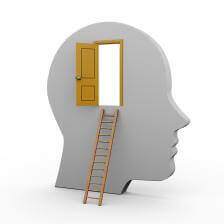How to Beat Writer’s Block and Other Creative Hurdles
Last week, we covered 6 habits and mindsets to coax creativity from all corners of your brain. This week, the Savvy Psychologist has 8 strategies you can use to karate-chop a creative block.
In Part 1 of this series on creativity we discussed the 6 ways to boost your creative juices. Make sure to check that out before you continue.

Here are 8 tips to bring it back to the negotiating table. The idea for this series comes from listener Ty C. of New York City.
Sponsor: Thanks to Audible for supporting our channel. Get a free audiobook of your choice at audiblepodcast.com/savvy.
Tip #1: Check Your Mood
It turns out the classic image of the moody, tortured creative artist isn’t quite right. Researchers at the University of Amsterdam looked at 25 years of studies on creativity and emotion and found that creativity is maximized when you’re in a good mood, not the throes of melancholic angst. In the study, feeling positive and happy was associated with greater creativity than feeling neutral. Feeling sad, notably, didn’t seem to do anything, and feeling anxious was associated with impaired creativity.
So if you’re feeling lousy, it’s still important to work on your project, but a quick mood-booster like doing some jumping jacks in your office, looking at pictures of your favorite vacation, or cuddling with your dog for a few minutes might be a good warm-up activity.
Tip #2: Try Open Monitoring Meditation
A 2012 study compared the effect of two types of meditation on the creative process. In the first type, focused attention meditation, the meditator focuses exclusively on a particular object, sensation, or thought, like a candle, her breath, or a mantra. All other distractions, like physical sensations, background noise, or intrusive thoughts, are to be filtered out and attention gently returned to the chosen target.
In the second type, known as open monitoring meditation, the meditator notices and observes any occurring thought, sensation, or emotion without judgment. In the study, the participants meditated for 35 minutes and then took some tests that measured, among other things, creativity.
When possibilities are endless, the block seems endless, too. But limits, counterintuitively, can be freeing.
Turns out that open-monitoring meditation—the kind where you notice all sensations and thoughts without judgment—was significantly better at promoting creative thinking than focused attention meditation.
So open your attention, and your mind may open creatively, too. However, it is worth noting that each participant was an experienced meditator, with an average of over 2 years of practice, so certainly try meditation in the moment, but also make it an ongoing practice.
Tip #3: Create Some Constraints
A cursor blinking on an otherwise blank computer screen, or an empty white canvas, or [insert your own paralyzing beginning here], often makes your mind feel the same way. When possibilities are endless, the block seems endless, too. But limits, counterintuitively, can be freeing.
So give yourself some constraints, much like you’d see in a school assignment. Rather than a goal to “paint,” try instituting some limitations, such as, “paint my happiest memory, using three types of media.” There. Rather than letting your imagination run endlessly until it drops in exhaustion, you just created some nice, neat boundaries in which it can play.
Tip #4: Separate Gathering from Creating

Tip #5: Sleep (and Smell) on it
We touched on sleep and creativity in the episode How to Be Creative, but this is such a fertile field of research we’ll revisit it from another perspective.
A 2012 study in the Journal of Sleep Research experimented with covertly compelling the mind work on a task during sleep. In the study, each participant was presented with a problem that required a creative solution: specifically, how to motivate people to volunteer. For some of the participants, an orange-vanilla scent filled the air while they learned about the problem, while others weren’t exposed to any scent at all. Of those exposed to the scent, half were then given a diffuser with the same orange-vanilla scent to put next to their beds while they slept that night, while half got a completely different scent.
The next morning, those who had smelled the orange vanilla scent both during the problem presentation and while sleeping generated more creative answers to the problem—that is, their answers were more useful and more novel than those who had smelled the other scent while sleeping or no scent at all. In addition, the matching-vanilla-scent participants were better able to pinpoint which of their ideas was most creative than those in the other groups.
Now, one study doesn’t make this technique a surefire bet, but if you want put matching diffusers in your creative workspace and next to your bed next time you hit a creative block, no one will judge you.
Tip #6: Relive Your Glory Days
When you’re stuck, try revisiting your own greatest hits. Look at the best painting you’ve ever painted. Read that award-winning story you wrote. Read your paper from that top scientific journal. Looking at our own bests can give you both a boost of confidence and a running start.
Tip #7: Put it Away and Work on Something Else
Last week, we talked about incubation—how, after tackling your problem initially, doing something unrelated can help boost creativity. This is true not only big picture, but in the moment.
In the midst of a creative block, rather than banging your head against the wall, direct your energy towards something else for a while. A creative and productive scientist colleague of mine recommends having three projects going at once—something just starting, something in the middle, and something wrapping up. Find the mix that works for you and you can usually find one project on which you can make creative progress.
Tip #8: Dance

However, they noted that participants who exercised regularly weren’t negatively influenced as much, and for some tasks, the exercise actually improved their performance a bit. Why is this? It’s possible that for people who are already physically fit, exercise is automatic and doesn’t take much attention, therefore providing the chance to incubate, or unconsciously chew on their creative problem. By contrast, for people who aren’t regular exercisers, having to engage in physical activity is challenging and takes conscious effort and monitoring, thus sapping their resources and reducing creative performance.
Yet couch potatoes need not despair: a brand new study in the Journal of Positive Psychology found that dancing for just 5 minutes enhanced both mood and creativity. Dancing behind a closed door takes zero skill and effort—no one will see you if you dance off the beat or look like a lunatic—so your brain is free to work on your block. So if a run around the neighborhood makes you feel like Bigfoot stomping on ants, don’t despair—a one-song dance party with no one watching may unlock your creative block.
Thanks for listening! And thanks for your thoughtful comments about Part 1 of my guest episode on Grammar Girl’s show. If you haven’t seen it yet, make sure to check out How Literature Changes the Brain for the Better. And If you can’t get enough, Part 2 is now available. Check it out on the always-fabulous Grammar Girl podcast. And be sure to connect with me on the Savvy Psychologist Facebook page or on Google+.
References

Campion, M. & Levita, L. (2014). Enhancing positive affect and divergent thinking abilities: Play some music and dance. The Journal of Positive Psychology, 9, 137-145.
Colzato, L.S., Ozturk, A., & Hommel, B. (2012). Meditate to create: the impact of focused-attention and open-monitoring training on convergent and divergent thinking. Frontiers in Psychology, 3: 116.
Ritter, S.M., Strick, M., Bos, M.W., Van Baaren, R.B, & Dijksterhuis, A. (2012). Good morning creativity: task reactivation during sleep enhances beneficial effect of sleep on creative performance. Journal of Sleep Research, 21: 643–647.
Colzato, L.S., Szapora, O.A., Pannekoek, J.N., & Hommel, B. (2013). The impact of physical exercise on convergent and divergent thinking. Frontiers in Human Neuroscience, 7: 824.
Disclaimer: All content is strictly for informational purposes only. This content does not substitute any medical advice, and does not replace any medical judgment or reasoning by your personal health provider. Please always seek a licensed physician in your area regarding all health related questions.
You May Also Like…






